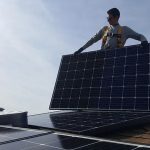A U.S.-Swedish research group has investigated the complex economic relationship between PV and heat pumps in cold climates under four different levels of electrification. It found that, compared to propane, solar heat pumps can reduce reduce costs by up to 20% and carbon emissions by 30%. DECEMBER 6, 2021 EMILIANO BELLINI
An international research team has sought to quantify the techno-economic characteristics of solar-powered heat pump solutions for residential buildings in isolated areas without natural gas supply in cold climates, and has found that, by resorting to the electrified solution, homeowners may reduce costs by up to 20%.
“The majority of studies in North America compare heat pumps to natural gas, which is logical given [the latter’s] dominance as a heating fuel,” the scientists explained. “Rural customers relying on, more expensive fuel oil or propane, however, represent a better opportunity for heat pumps and no studies were found using these fuels as a baseline comparison.”
Their work considered, in particular, isolated areas in the U.S. Upper Midwest and the northeast of the nation, and archetypal buildings that were modeled under four levels of electrification, for each of which PV sizing analysis was conducted. The four levels are described as follows: A baseline case in which propane serves all heating needs; a case where a heat pump is used for producing hot water; full electrification of the building’s heating system; and a second fully electrified level that also provides cooling in the summer.
The economic performance of the four levels was evaluated through total life cycle cost (TLCC) and a self-consumption pricing model. The analysis also took into account the envelope efficiencies of residential buildings and the Midwestern generation mix available today. “Economic sensitivities are analyzed on capital costs, electricity and propane prices, and discount rates,” the scientists emphasized. “Climatic, construction, occupancy behavior, and economic boundary conditions are taken from Michigan but are considered representative of most buildings in North America’s cold climate zones.” The technical analysis was carried out by identifying a project’s primary energy renewable fraction (PREF), which considers all energy sources used in the final supply of electricity and heat to the building. The maximum capacity of a PV system must be equal to a household’s electricity load over the year.
Through the analysis, the academics found that heat pumps are already economically competitive with propane in isolated areas in northern climates, regardless of whether a PV system is installed or not. The cost-optimal solution was found to be that of the second level, in which the solar-powered heat pump is used for hot water production, assuming that solar module costs will further drop in the future. “The high capital cost of PV remains a barrier, however past work has shown … the majority can still gain access to capital [and] take advantage of existing support programs and/or third-party business models,” the researchers explained.
According to their calculations, homeowners would face no lifecycle economic costs when heat pumps are a drop-in replacement. “Even with 50% higher capital costs than average market prices, the lower operational costs of heat pumps compensate,” they emphasized, noting that heating electrification solutions such as solar heat pumps may reduce cost by up to 20% and carbon emissions by 30%.
They also warned, however, that their conclusions are strictly dependent on the region’s electricity prices. “Lower retail prices benefit heat pumps but harm PV while higher sell-back prices help support PV even when electricity prices are lower, suggesting that a trade-off can be made with utilities, where lost revenues from distributed PV can be more than compensated by the increased demand from heat pumps,” they highlighted.
he model is described in the study Decarbonizing rural residential buildings in cold climates: A techno-economic analysis of heating electrification, published in Energy and Buildings. The research group includes scientists from the Michigan Technological University, in the United States, and the KTH Royal Institute of Technology, in Sweden.




